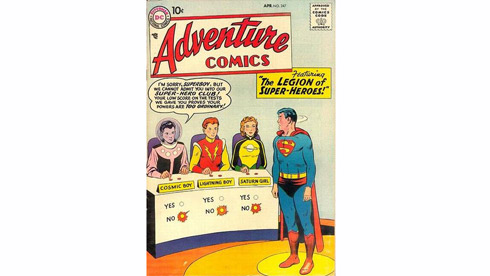
April 1958: Adventure Comics #258. Otto Binder and Al Plastino create the Legion of Super-Heroes, a club of teenage superheroes a thousand years in the future, who bring Superboy to their time and tell him that he was their inspiration. The group catches on, appearing a handful of times over the next few years.
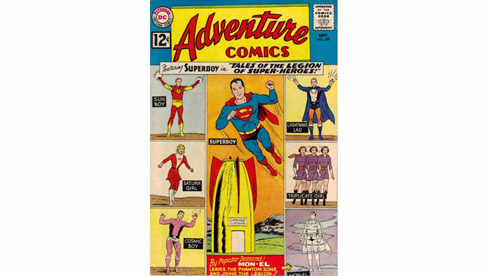
September 1962: Adventure Comics #300. Superboy’s team-ups with the Legion become a regular feature in Adventure, where they will remain through May 1969’s #380. This first story is written by Superman co-creator Jerry Siegel and drawn by John Forte with Al Plastino.
(More on Techland: The Secret Comics History of “The Losers”)
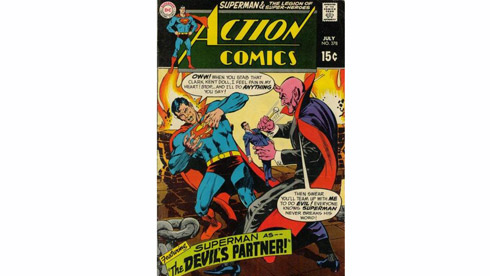
July 1969: Action Comics #378. The Legion becomes a backup feature in Action with this issue’s Jim Shooter/Win Mortimer story (following a reprint in the previous issue), and remains there for a bit more than a year. (Shooter, at this point, has been writing Legion stories since 1966–he sold his first script for the series at the age of 14.) Following its Action run, the Legion becomes an intermittent backup feature in Superboy for a couple of years, beginning with March 1971’s #172.
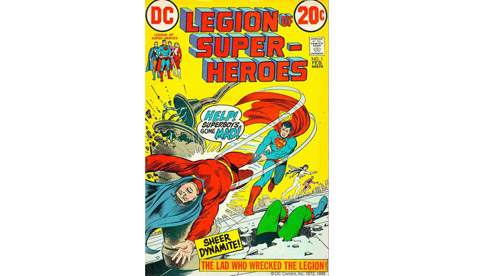
February 1973: Legion of Super-Heroes #1. The first series to be named after the Legion actually reprints stories from the mid-’60s. It lasts four issues.
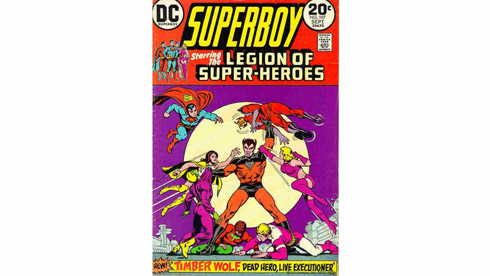
September 1973: Superboy #197. That’s what it says in the indicia, anyway, but on the cover it’s now Superboy Starring the Legion of Super-Heroes–a title it will retain for the next few years, becoming Superboy and the Legion of Super-Heroes on its cover at the end of 1976. This issue’s lead story is by Cary Bates and Dave Cockrum.
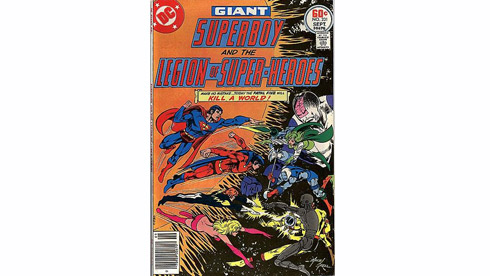
September 1977: Superboy and the Legion of Super-Heroes #231, the first issue whose indicia features the new official title of the series, is written by 20-year-old Paul Levitz and drawn by James Sherman, Jack Abel and Mike Netzer.
(More on Techland: Exclusive Preview: Firestar #1 Art by Emma Rios)
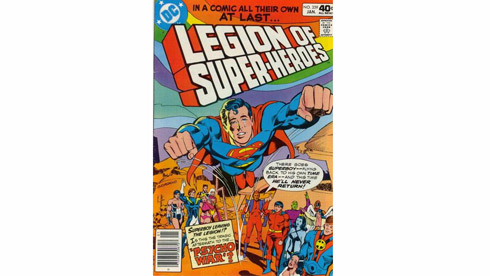
January 1980: Legion of Super-Heroes volume 2, #259. Superboy is kicked out of the title that used to be his (and moves over to a new, freshly numbered comic book); the Legion take it over as their own series, and finally get a half-decent logo. This issue’s by Gerry Conway, Joe Staton and Dave Hunt. Paul Levitz returns with #284, Keith Giffen joins him with #287, and all of a sudden the team catches on in a big way again.
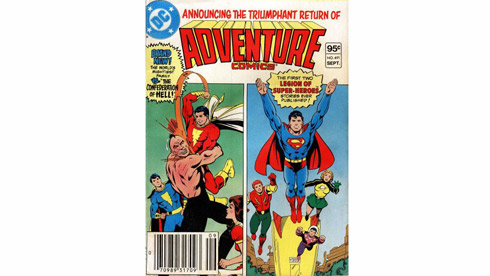
September 1982: Adventure Comics #491. The Legion return to Adventure in reprint form: now a digest-size anthology, Adventure reprints a couple of early Legion stories each issue. It gives up the ghost with September, 1983’s #503.
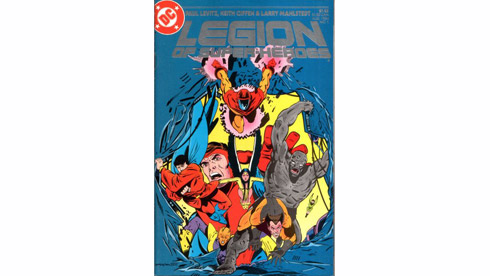
August 1984: Legion of Super-Heroes volume 3, #1. Legion has now become so popular that a new series is launched (by Levitz, Giffen and Larry Mahlstedt) with a “hardcover/softcover” plan: it’s printed on extra-nice Baxter paper with a $1.25 cover price and sold only in comic book stores. It runs for 63 issues. Meanwhile, the previous Legion series (75 cents, less nice paper, sold on newsstands too) is retitled Tales of the Legion of Super-Heroes with #314; for its first year, it features new material, and then continues with one-year-later reprints of the Baxter series, finally being cancelled with #354.
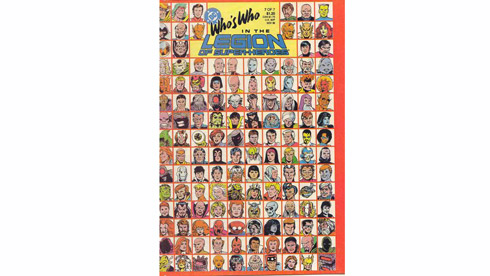
April 1988: Who’s Who in the Legion of Super-Heroes #1. The level of complexity of the main Legion series by this point may be suggested by the fact that there is a seven-issue miniseries devoted to explaining who all of its characters are. This is sometimes perceived as a bug and sometimes as a feature. By this point, John Byrne has rebooted the Superman franchise, declaring that there had retroactively never been an in-continuity Superboy, so Byrne and Levitz devise a complicated bit of business involving a “pocket universe”–an alternate timeline in which there had in fact been a Superboy who worked with the Legion.
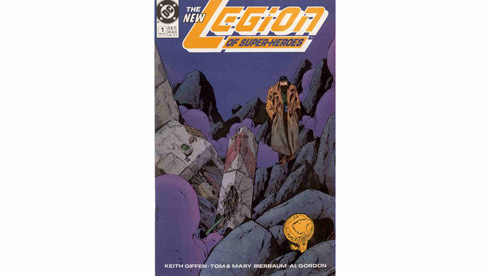
November 1989: Legion of Super-Heroes volume 4, #1. Keith Giffen, Tom and Mary Bierbaum and Al Gordon launch a very different take on the Legion, set five years after the end of volume 3. It’s wildly stylized, incredibly smart and clever and elegant, and apparently too “difficult” for some readers. It’s also initially hampered by the DC editorial decision that the “pocket universe” wouldn’t fly either, so the series gets two mini-reboots within its first five issues to clear that up. (At this point, I could attempt to explain what Batch SW6 was, but there are limits even to my willingness to confuse Techland’s readers. Don’t even ask how Supergirl fits into the picture.)
(More on Techland: Exclusive Preview: Peter Bagge’s “Other Lives”)
Giffen leaves after a couple of years, and Legion’s storytelling becomes somewhat more straightforward; it also spawns a spinoff title, Legionnaires, in April 1993. During the Zero Hour crossover event of 1994, the Legion’s timeline comes to an end, and September 1994’s Legion of Super-Heroes #61 ends with a great tearjerker scene in which the team members disappear into the void, one by one, followed by several blank pages.
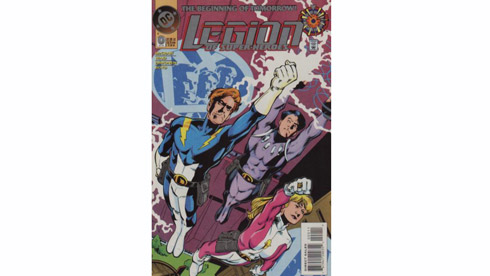
October 1994: Legion of Super-Heroes volume 4, #0. The existing Legion series is relaunched with a zero issue, by Tom McCraw, Mark Waid, Stuart Immonen and Ron Boyd. (So is Legionnaires, by Waid, McCraw, Boyd and Jeffrey Moy.) This time, they start fresh, throwing out all the old continuity and introducing the characters as if for the first time. (Longtime readers refer to this team as the “reboot” or “Mark 2” Legion.) The next month, the new incarnations of Legion and Legionnaires continue with their titles’ then-current numbering–#62 and #19, respectively. Both titles run until March 2000, by which point the team of Dan Abnett and Andy Lanning is writing them. They’re followed by the mostly Abnett/Lanning-written Legion Lost (12 issues, 2000-2001), Legion Worlds (6 issues, 2001) and The Legion (38 issues, 2001-2004). By the end, there’s a new Superboy, who’s naturally joined the team.
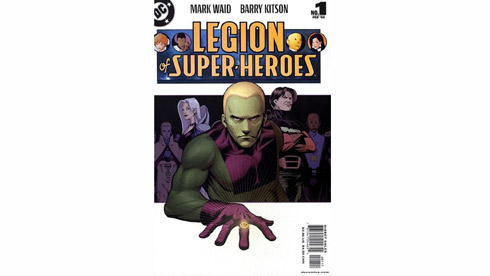
February 2005: Legion of Super-Heroes volume 5, #1. Waid (this time with artists Barry Kitson and Mick Gray) starts from scratch with the Legion again, ditching both the first and the second incarnations’ continuity and recasting the team as something of a youth movement; this becomes known as the “Mark 3” or “threeboot” Legion. With #16, it becomes Supergirl and the Legion of Super-Heroes (Supergirl was kind of a hot property for a while around then); with #37, Jim Shooter and Francis Manapul take over, and the title goes back to Legion of Super-Heroes. This incarnation gives up the ghost with March 2009’s #50, whose script is credited to the pseudonymous “Justin Thyme.”
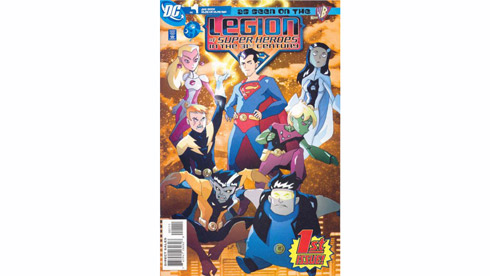
June 2007: Legion of Super-Heroes in the 31st Century #1. J. Torres and Chynna Clugston launch a series for younger readers, based on the CW’s Legion of Super Heroes animated series (in which they’re joined by “the young Superman,” Superboy being something of a legal hot potato at this point). It runs 20 issues.
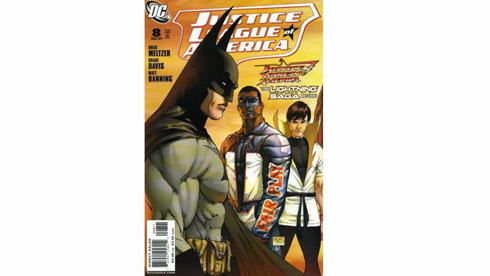
Also June 2007: Justice League of America #8. “The Lightning Saga,” a five-part crossover between the Brad Meltzer-written Justice League of America and the Geoff Johns-written Justice Society of America, introduces the Legion to the 21st century–but not the same Legion that was appearing in Waid and Kitson’s Supergirl and the Legion of Super-Heroes at the same time. The “Lightning Saga” Legion is, in fact, a somewhat older version of the 1955-1989 incarnation, disregarding all the “five year gap” material published between 1989 and 1994. Let’s call them the “Mark 1.5” Legion. They go on to appear in Johns and Gary Frank’s nifty “Superman and the Legion of Super-Heroes” story in Action Comics #858-863. (#858 is being reprinted for a buck next week, incidentally.)
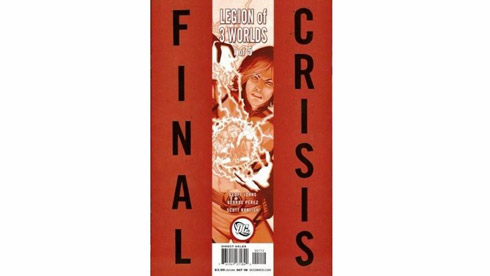
October 2008: Final Crisis: Legion of Three Worlds #1. Despite its title, this Geoff Johns/George Pérez miniseries is just barely a Final Crisis tie-in. It is, however, a team-up of three incarnations of the Legion–Mark 1.5, Mark 2 and Mark 3–which gives Johns a chance to seed a few storylines for his Adventure Comics revival, and Pérez a chance to draw a billion characters on every page. It’s a lot of fun.
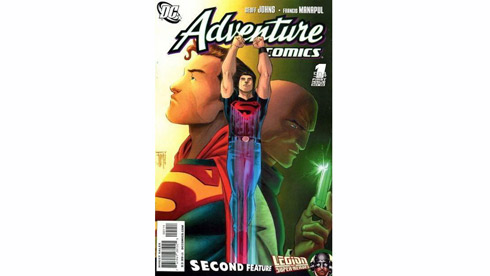
October 2009: Adventure Comics #1. Following a #0 issue in April, Johns, Manapul and Clayton Henry relaunch Adventure Comics as an ongoing series featuring Superboy in the lead position and the Legion (Mark 1.5) as a backup. (For the sake of historical continuity and extra confusion, each issue has a variant cover picking up the original Adventure numbering from 1983, starting with #504.) The Legion gets bumped from #5-7, and there’s a four-part, many-writer tie-in with the Superman titles in #8-11. Paul Levitz and Kevin Sharpe take over with next month’s #12; the following issue will be numbered as #516, and shift to a new format with Superboy-and-the-Legion as the lead feature, and the Atom as a backup.
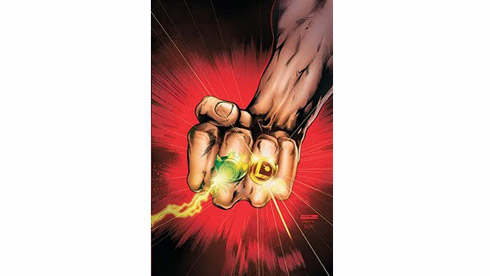
May 2010: The Legion of Super-Heroes volume 6, #1. In the launch issue that comes out this week, Paul Levitz returns to the Legion (working with Turkish artist Yildiray Cinar), picking up roughly where Johns left off. Levitz has noted that he’s trying to write “a good first Legion book… an introduction to the characters.” Maybe the sixth time’s the charm!
More on Techland:
Exclusive Preview: The Atomic Knights

